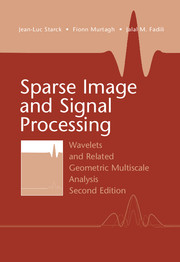Book contents
- Frontmatter
- Contents
- List of Acronyms
- Notation
- Foreword
- 1 Introduction to the World of Sparsity
- 2 The Wavelet Transform
- 3 Redundant Wavelet Transform
- 4 Nonlinear Multiscale Transforms
- 5 Multiscale Geometric Transforms
- 6 Sparsity andNoiseRemoval
- 7 Linear Inverse Problems
- 8 Morphological Diversity
- 9 Sparse Blind Source Separation
- 10 Dictionary Learning
- 11 Three-Dimensional Sparse Representations
- 12 Multiscale Geometric Analysis on the Sphere
- 13 Compressed Sensing
- 14 This Book's Take-Home Message
- Notes
- References
- Index
- Plate section
14 - This Book's Take-Home Message
Published online by Cambridge University Press: 05 October 2015
- Frontmatter
- Contents
- List of Acronyms
- Notation
- Foreword
- 1 Introduction to the World of Sparsity
- 2 The Wavelet Transform
- 3 Redundant Wavelet Transform
- 4 Nonlinear Multiscale Transforms
- 5 Multiscale Geometric Transforms
- 6 Sparsity andNoiseRemoval
- 7 Linear Inverse Problems
- 8 Morphological Diversity
- 9 Sparse Blind Source Separation
- 10 Dictionary Learning
- 11 Three-Dimensional Sparse Representations
- 12 Multiscale Geometric Analysis on the Sphere
- 13 Compressed Sensing
- 14 This Book's Take-Home Message
- Notes
- References
- Index
- Plate section
Summary
In this book, we have presented in detail how sparsity can be used to regularize a variety of inverse problems in signal, image, and more generally data processing. We have shown that sparse recovery involves four main ingredients that are the keys its its success. These ingredients are
▪ The dictionary: fixed dictionaries with fast analysis and synthesis operators, such as X-lets (including wavelets or curvelets described in Chapters 3, 5, 11, and 12), allow us to build very efficient algorithms, both in terms of computation time and of quality of the recovered solutions. We have seen in Chapter 8 that these fixed dictionaries can be gathered together to build a larger dictionary, but still using fast operators. To go beyond these fixed dictionaries, dictionary learning in Chapter 10 appears to be a promising paradigm to learn dictionaries adapted to the analyzed data. We showed its efficiency in astronomical image denoising and how it exceeds the performance of state-of-the-art denoising algorithms that use nonadaptive dictionaries.
▪ The noise modeling: having the right dictionary is only a part of the story and is not enough. In most inverse problems, one needs to disentangle the useful signal/information from the noise. This requires taking properly into account the noise behavior in the observed data. In a denoising setting, we have seen in Chapter 6 how this can be achieved for different kinds of noise models, such as Gaussian, Poisson, mixture of Gaussian and Poisson, and correlated noise, and can be used to derive the distribution of the coefficients and therefore to detect, with a given confidence level, significant coefficients that should be used to reconstruct the signal of interest.
▪ The variational problem and minimization algorithm: piecing together the first ingredient and the second one (i.e., regularization and data fidelity), solving the inverse problem at hand becomes solving a variational (optimization) problem. We have shown throughout the book how this can be achieved for several verse problems (e.g., Chapters 7, 8, and 9). To solve the obtained optimization problem, we described in Chapter 7 a very general class of optimization schemes, namely proximal splitting algorithms, that are fast, are easy to implement, and enjoy provable convergence.
Information
- Type
- Chapter
- Information
- Sparse Image and Signal ProcessingWavelets and Related Geometric Multiscale Analysis, pp. 391 - 394Publisher: Cambridge University PressPrint publication year: 2015
